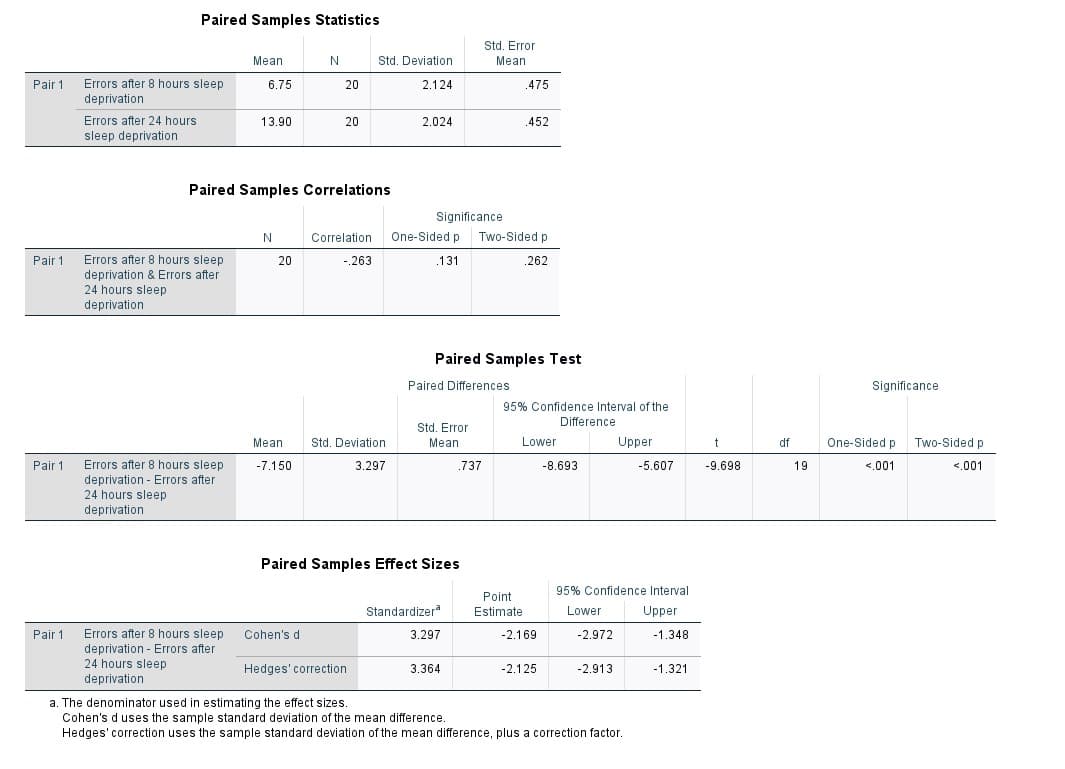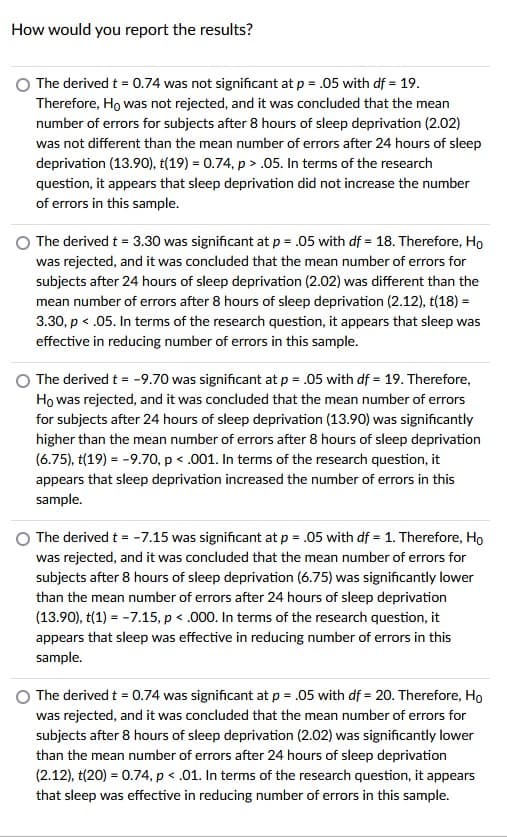How would you report the results? The derived t = 0.74 was not significant at p = .05 with df = 19. Therefore, Ho was not rejected, and it was concluded that the mean number of errors for subjects after 8 hours of sleep deprivation (2.02) was not different than the mean number of errors after 24 hours of sleep deprivation (13.90), t(19) = 0.74, p > .05. In terms of the research question, it appears that sleep deprivation did not increase the number of errors in this sample. The derived t = 3.30 was significant at p .05 with df = 18. Therefore, Ho was rejected, and it was concluded that the mean number of errors for subjects after 24 hours of sleep deprivation (2.02) was different than the mean number of errors after 8 hours of sleep deprivation (2.12), t(18) = 3.30, p < .05. In terms of the research question, it appears that sleep was effective in reducing number of errors in this sample. O The derived t = -9.70 was significant at p = .05 with df = 19. Therefore, Ho was rejected, and it was concluded that the mean number of errors for subjects after 24 hours of sleep deprivation (13.90) was significantly higher than the mean number of errors after 8 hours of sleep deprivation (6.75), t(19) = -9.70, p < .001. In terms of the research question, it appears that sleep deprivation increased the number of errors in this sample. O The derived t = -7.15 was significant at p .05 with df 1. Therefore, Ho was rejected, and it was concluded that the mean number of errors for subjects after 8 hours of sleep deprivation (6.75) was significantly lower than the mean number of errors after 24 hours of sleep deprivation (13.90), t(1) = -7.15, p < .000. In terms of the research question, it appears that sleep was effective in reducing number of errors in this sample. O The derived t = 0.74 was significant at p = .05 with df = 20. Therefore, Ho was rejected, and it was concluded that the mean number of errors for subjects after 8 hours of sleep deprivation (2.02) was significantly lower than the mean number of errors after 24 hours of sleep deprivation (2.12), t(20) = 0.74, p<.01. In terms of the research question, it appears that sleep was effective in reducing number of errors in this sample.
How would you report the results? The derived t = 0.74 was not significant at p = .05 with df = 19. Therefore, Ho was not rejected, and it was concluded that the mean number of errors for subjects after 8 hours of sleep deprivation (2.02) was not different than the mean number of errors after 24 hours of sleep deprivation (13.90), t(19) = 0.74, p > .05. In terms of the research question, it appears that sleep deprivation did not increase the number of errors in this sample. The derived t = 3.30 was significant at p .05 with df = 18. Therefore, Ho was rejected, and it was concluded that the mean number of errors for subjects after 24 hours of sleep deprivation (2.02) was different than the mean number of errors after 8 hours of sleep deprivation (2.12), t(18) = 3.30, p < .05. In terms of the research question, it appears that sleep was effective in reducing number of errors in this sample. O The derived t = -9.70 was significant at p = .05 with df = 19. Therefore, Ho was rejected, and it was concluded that the mean number of errors for subjects after 24 hours of sleep deprivation (13.90) was significantly higher than the mean number of errors after 8 hours of sleep deprivation (6.75), t(19) = -9.70, p < .001. In terms of the research question, it appears that sleep deprivation increased the number of errors in this sample. O The derived t = -7.15 was significant at p .05 with df 1. Therefore, Ho was rejected, and it was concluded that the mean number of errors for subjects after 8 hours of sleep deprivation (6.75) was significantly lower than the mean number of errors after 24 hours of sleep deprivation (13.90), t(1) = -7.15, p < .000. In terms of the research question, it appears that sleep was effective in reducing number of errors in this sample. O The derived t = 0.74 was significant at p = .05 with df = 20. Therefore, Ho was rejected, and it was concluded that the mean number of errors for subjects after 8 hours of sleep deprivation (2.02) was significantly lower than the mean number of errors after 24 hours of sleep deprivation (2.12), t(20) = 0.74, p<.01. In terms of the research question, it appears that sleep was effective in reducing number of errors in this sample.
Glencoe Algebra 1, Student Edition, 9780079039897, 0079039898, 2018
18th Edition
ISBN:9780079039897
Author:Carter
Publisher:Carter
Chapter10: Statistics
Section10.1: Measures Of Center
Problem 4GP
Related questions
Question

Transcribed Image Text:Paired Samples Statistics
Std. Error
Mean
Std. Deviation
Mean
Errors after 8 hours sleep
deprivation
Pair 1
6.75
20
2.124
.475
Errors after 24 hours
13.90
20
2.024
.452
sleep deprivation
Paired Samples Correlations
Significance
N
Correlation
One-Sided p
Two-Sided p
Pair 1
Errors after 8 hours sleep
20
-.263
.131
.262
deprivation & Errors after
24 hours sleep
deprivation
Paired Samples Test
Paired Differences
Significance
95% Confidence Interval of the
Difference
Std. Error
Mean
Std. Deviation
Mean
Lower
Upper
t
df
One-Sided p Two-Sided p
Errors after 8 hours sleep
deprivation - Errors after
24 hours sleep
deprivation
Pair 1
-7.150
3.297
.737
-8.693
-5.607
-9.698
19
<.001
<.001
Paired Samples Effect Sizes
95% Confidence Interval
Point
Standardizer
Estimate
Lower
Upper
Errors after 8 hours sleep
deprivation - Errors after
24 hours sleep
Pair 1
Cohen's d
3.297
-2.169
-2.972
-1.348
Hedges' correction
3.364
-2.125
-2.913
-1.321
deprivation
a. The denominator used in estimating the effect sizes.
Cohen's d uses the sample standard deviation of the mean difference.
Hedges' correction uses the sample standard deviation of the mean difference, plus a correction factor.

Transcribed Image Text:How would you report the results?
The derived t = 0.74 was not significant at p = .05 with df = 19.
Therefore, Ho was not rejected, and it was concluded that the mean
number of errors for subjects after 8 hours of sleep deprivation (2.02)
was not different than the mean number of errors after 24 hours of sleep
deprivation (13.90), t(19) = 0.74, p > .05. In terms of the research
question, it appears that sleep deprivation did not increase the number
of errors in this sample.
The derived t = 3.30 was significant at p = .05 with df = 18. Therefore, Ho
was rejected, and it was concluded that the mean number of errors for
subjects after 24 hours of sleep deprivation (2.02) was different than the
mean number of errors after 8 hours of sleep deprivation (2.12), t(18) =
3.30, p < .05. In terms of the research question, it appears that sleep was
effective in reducing number of errors in this sample.
The derived t = -9.70 was significant at p = .05 with df = 19. Therefore,
Họ was rejected, and it was concluded that the mean number of errors
for subjects after 24 hours of sleep deprivation (13.90) was significantly
higher than the mean number of errors after 8 hours of sleep deprivation
(6.75), t(19) = -9.70, p < .001. In terms of the research question, it
appears that sleep deprivation increased the number of errors in this
sample.
The derived t = -7.15 was significant at p = .05 with df = 1. Therefore, Ho
was rejected, and it was concluded that the mean number of errors for
subjects after 8 hours of sleep deprivation (6.75) was significantly lower
than the mean number of errors after 24 hours of sleep deprivation
(13.90), t(1) = -7.15, p < .000. In terms of the research question, it
appears that sleep was effective in reducing number of errors in this
sample.
The derived t = 0.74 was significant at p = .05 with df = 20. Therefore, Ho
was rejected, and it was concluded that the mean number of errors for
subjects after 8 hours of sleep deprivation (2.02) was significantly lower
than the mean number of errors after 24 hours of sleep deprivation
(2.12), t(20) = 0.74, p < .01. In terms of the research question, it appears
that sleep was effective in reducing number of errors in this sample.
Expert Solution
This question has been solved!
Explore an expertly crafted, step-by-step solution for a thorough understanding of key concepts.
Step by step
Solved in 2 steps

Recommended textbooks for you

Glencoe Algebra 1, Student Edition, 9780079039897…
Algebra
ISBN:
9780079039897
Author:
Carter
Publisher:
McGraw Hill

Glencoe Algebra 1, Student Edition, 9780079039897…
Algebra
ISBN:
9780079039897
Author:
Carter
Publisher:
McGraw Hill